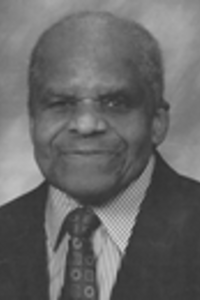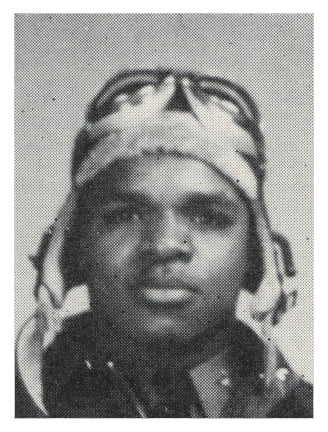Celebrating Black Engineers: Luther H. Smith Jr
Honor Wall Biography
 Luther H. Smith
Luther H. Smith
BS 1950 in Mechanical Engineering
Luther H. Smith of Villanova, PA, was a retired U.S. Air Force captain who flew 133 combat missions in World War II, and was a retired General Electric Co. engineer with 37 years service and two U.S. patents. A native of Des Moines, IA, Captain Smith was an original member of the famed Tuskegee Airmen. He flew 133 missions and is credited with destroying two German enemy aircraft in aerial combat and 10 German aircraft in ground strafing missions. He was awarded the Distinguished Flying Cross, Air Medal with six Oak Leaf Clusters, Purple Heart, eight European and Mediterranean Theaters Campaign Ribbons, and the Prisoner of War Medal after being permanently injured on his final combat mission, parachuting while unconscious from his burning P-51 Mustang aircraft, and held as a prisoner for seven months until the war ended.
After earning his B.S. degree at The University of Iowa, Captain Smith worked for GE’s Missile and Space Operations in Philadelphia until his retirement in 1988. He held two U.S. patents, had published numerous technical documents and publications, and worked on special assignments with the U.S. Air Force, NASA, and U.S. Navy Submarine Command. Captain Smith was a recipient of the Society of Automotive Engineers, Aerospace International, Franklin W. Kolk Aerospace Industry Award. He served on the Architect-Engineer Evaluation Jury that chose the design for the World War II Memorial, and worked tirelessly to gain recognition for the contributions of the Tuskegee Airmen. In June 2004, he headed the 60th anniversary celebration of the Tuskegee Airmen’s greatest World War II achievement, escorting American heavy strategic bombers on 200 missions throughout Europe without the loss of a single bomber to enemy aircraft.
Until his death in 2009, Captain Smith contributed significantly to the achievement of racial equality in the U.S. and the world and helped change the face of the U.S. military in a remarkably short period of time. In 2005, he was inducted as a member of the College of Engineering's Distinguished Engineering Alumni Academy. In February 2006, Smith received an honorary doctorate degree in public service from Tuskegee University. In June 2006, he was awarded the UI Alumni Association Distinguished Alumni Award for Achievement and in October 2006 he was inducted into the Iowa Aviation Hall of Fame. In March 2007, Smith was presented the Congressional Gold Medal, the highest civilian award bestowed by the U.S. Congress.
Prisoner of War Oral History Project
-
Prisoner of War Oral History Project - Luther Smith Jr.Phone Interview of Luther Smith Jr on February 7, 2005 by Thomas Saylor of Concordia University
Interview Abstract:
Luther H. Smith, Jr., was born 27 September 1920 in Des Moines, Iowa, and raised there as well. He attended the University of Iowa from 1938-41, then enrolled in the Civilian Pilot Training Course, a program to train pilots. Luther enlisted in the US Army Air Corps in September 1942, and completed Air Corps training as a fighter pilot. He served with the 302nd Fighter Squadron of the 332nd Fighter Group, and was one of the Tuskegee Airmen. In January 1944, Luther joined his overseas unit and began flying missions from bases in Italy. By October 1944, he had completed more than one hundred. According to a 2009 article in the Philadelphia Inquirer and Luther's records, "he was credited with destroying two enemy aircraft in aerial combat and ten aircraft in ground strafing missions. He received the Distinguished Flying Cross, and an Air Medal with six Oak Leaf Clusters." On 13 October 1944, Luther's plane, a P-47 Mustang fighter aircraft, was shot down while on a mission escorting American bombers to Germany. He bailed out, but was badly injured. His German captors sent him first to Luftwaffe (German Air Force) hospitals, then to a hospital prison camp facility, Stalag XVIII-A at Spittal, in southern Austria. Luther remained here for the duration of the war, and was liberated by US forces in early May 1945. After his return to the United States, Luther had a long recovery from his injuries. He remained in the Air Corps (after 1947, Air Force), retiring in 1947. He then completed a degree in engineering at the University of Iowa in 1950, and had a career as an aerospace engineer for General Electric Co. In 1995, Captain Smith accompanied President Bill Clinton to Europe with six other veterans for the fiftieth anniversary marking the end of World War II. He also served on the Architect-Engineer Evaluation Jury to select the design for the National World War II Memorial in Washington.
-
Luther Smith, Jr. - TranscriptPDF Transcript of Interview with Luther Smith, Jr.
Link asks to download PDF
Profiles of Tuskegee Airmen - Luther H. Smith
-
CAF RISE ABOVE Smith ProfileCAF RISE ABOVE is an educational outreach program that brings the history and legacy of the Tuskegee Airmen and Women Airforce Service Pilots (WASP) to life in communities and classrooms everywhere.
 Character. What we do with what we’ve been given. What we do in the face of adversity. What we do when times are good, and bad. In the profile of Capt Luther Smith – original Tuskegee Airman, engineer, patent-holder, community servant and father – we are given a great example of this valuable trait.
Character. What we do with what we’ve been given. What we do in the face of adversity. What we do when times are good, and bad. In the profile of Capt Luther Smith – original Tuskegee Airman, engineer, patent-holder, community servant and father – we are given a great example of this valuable trait.
Iowa PBS World War II Stories
The Tuskegee Airmen, officially known as the 332nd fighter group, were the first African Americans to fly planes in the U.S. military. Although they faced severe discrimination in the country and mandates of the Jim Crow laws in the south, they volunteered in large numbers to help fight in World War II. This segment of Iowa Public Television's Iowa’s WWII Stories includes historical footage and profiles an Iowa veteran and member of the Tuskegee Airmen.
 Luther H. Smith
Luther H. Smith